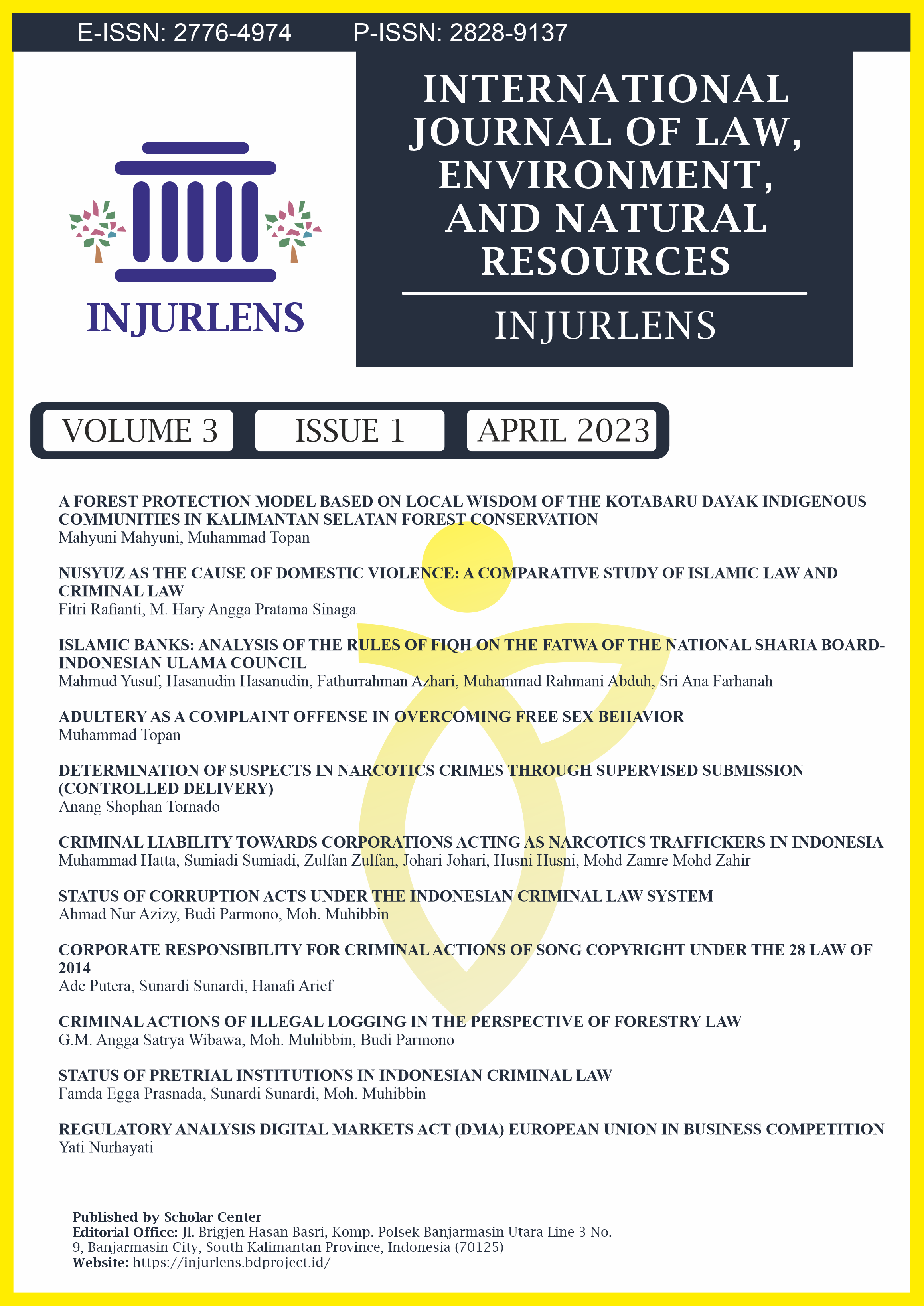Criminal Liability Towards Corporations Acting As Narcotics Traffickers In Indonesia
DOI:
https://doi.org/10.51749/injurlens.v3i1.61Keywords:
Liability, Corporations, Perpetrators, Trafficking, Narcotics, IndonesiaAbstract
Corporate crime is often referred to as a crime committed by a legal entity or organization. Corporate involvement in criminal activity can enable criminal access to methods of production, storage, distribution, or trading. In the context of narcotics crime, corporations could play a significant role in the trafficking of narcotics through a variety of modus operandi including production, distribution, and sales to the general public. Therefore, corporation as a legal subject can be held accountable. This study uses a statutory approach and is normative (doctrinal). It solely employs secondary data and is processed qualitatively to describe facts, documents, information, and other data related to criminal liability for corporations as perpetrators of narcotics trafficking in Indonesia. The embodiment of criminal liability towards corporations as perpetrators of narcotics trafficking is regulated in several provisions, including Article 130 of Law No. 35 of 2009 concerning Narcotics as well as Articles 60 to 64 and Article 70 of Law No. 5 of 1997 concerning Psychotropics. The crime of narcotics distribution through corporation involves businesses or legal entities such as hospitals, health clinics, pharmacies and others. Revocation of business licenses can be used as punishment for those companies, while the management may also face further legal repercussions.
Downloads
References
Adhitia, F. B. (2017). Sepanjang Tahun 2017, BNN Ungkap 46.537 Kasus Narkoba. Www.Idntimes.Com. https://www.idntimes.com/news/indonesia/fitang-adhitia/sepanjang-tahun-2017-bnn-ungkap-46537-kasus-narkoba/full
Bossouni, M. C. (1978). Substantive Criminal Law. Charles C Thomas Pub Ltd.
Budianto, A. (2012). Delik Suap Korporasi di Indonesia (1st ed.). CV.Karya Putra Darwati.
Kiaking, C. J. (2017). Penyalahgunaan Narkotika Menurut Hukum Pidana Dan Undang-Undang Nomor 35 Tahun 2009 tentang Narkotika. Lex Crimen, 6(1), 106–114.
McCrudden. (2006). Legal Research and the Social Sciences. Law Quarterly Review, 4, 632–650.
Muladi. (1995). Kapita Selekta Sistem Peradilan Pidana. Badan Penerbit Universitas Diponegoro.
Primantari, V. A. (2013). Efektifitas Kampanye Anti Penyalahgunaan Narkoba Terhadap Pengetahuan dan Sikap Remaja Akan Bahaya Penyalahgunaan Narkoba (Studi Terhadap Remaja di Kelurahan Sukaraja Kecamatan Teluk Betung Selatan, Kota Bandar Lampung). Jurnal Sociologie, 1(2), 93–94.
QC, A. P. (2008). Corporate Criminal Liability. Sweet & Maxwell.
Rowe, S. E. (2009). Legal Research, Legal Analysis, and Legal Writing: Putting Law School into Practice. SSRN ELibrary, 1193(2000), 1–19.
Sakti, N. W. (2018). Memerangi Narkoba. Media Keuangan, XIII(127), 3.
Sasangka, H. (2003). Narkotika dan Psikotropika Dalam Hukum Pidana. Mandar Maju.
Sekretariat DPR RI. (2017). Laporan Singkat Rapat Dengar Pendapat Komisi III DPR RI dengan Badan Narkotika Nasional: Bidang Hukum, Perundang-Undangan, HAM dan Keamanan. Sekretariat DPR RI.
Susanti, H. (2018). Latar Belakang Penjatuhan Sanksi Pidana Mati Terhadap Pelaku Tindak Pidana Narkotika didalam UU No. 35 Tahun 2009 Tentang Narkotika. UIR Law Review, 2(1), 266–277.
United Nations Office on Drugs and Crime. (2017). The Drug Problem And Organized Crime, Illicit Financial Flows, Corruption and Terrorism, World Drug Report, United Nations publication, 2017, hlm. 15-19. United Nations publication.
Adhitia, F. B. (2017). Sepanjang Tahun 2017, BNN Ungkap 46.537 Kasus Narkoba. Www.Idntimes.Com. https://www.idntimes.com/news/indonesia/fitang-adhitia/sepanjang-tahun-2017-bnn-ungkap-46537-kasus-narkoba/full
Bossouni, M. C. (1978). Substantive Criminal Law. Charles C Thomas Pub Ltd.
Budianto, A. (2012). Delik Suap Korporasi di Indonesia (1st ed.). CV.Karya Putra Darwati.
Kiaking, C. J. (2017). Penyalahgunaan Narkotika Menurut Hukum Pidana Dan Undang-Undang Nomor 35 Tahun 2009 tentang Narkotika. Lex Crimen, 6(1), 106–114.
McCrudden. (2006). Legal Research and the Social Sciences. Law Quarterly Review, 4, 632–650.
Muladi. (1995). Kapita Selekta Sistem Peradilan Pidana. Badan Penerbit Universitas Diponegoro.
Primantari, V. A. (2013). Efektifitas Kampanye Anti Penyalahgunaan Narkoba Terhadap Pengetahuan dan Sikap Remaja Akan Bahaya Penyalahgunaan Narkoba (Studi Terhadap Remaja di Kelurahan Sukaraja Kecamatan Teluk Betung Selatan, Kota Bandar Lampung). Jurnal Sociologie, 1(2), 93–94.
QC, A. P. (2008). Corporate Criminal Liability. Sweet & Maxwell.
Rowe, S. E. (2009). Legal Research, Legal Analysis, and Legal Writing: Putting Law School into Practice. SSRN ELibrary, 1193(2000), 1–19.
Sakti, N. W. (2018). Memerangi Narkoba. Media Keuangan, XIII(127), 3.
Sasangka, H. (2003). Narkotika dan Psikotropika Dalam Hukum Pidana. Mandar Maju.
Sekretariat DPR RI. (2017). Laporan Singkat Rapat Dengar Pendapat Komisi III DPR RI dengan Badan Narkotika Nasional: Bidang Hukum, Perundang-Undangan, HAM dan Keamanan. Sekretariat DPR RI.
Susanti, H. (2018). Latar Belakang Penjatuhan Sanksi Pidana Mati Terhadap Pelaku Tindak Pidana Narkotika didalam UU No. 35 Tahun 2009 Tentang Narkotika. UIR Law Review, 2(1), 266–277.
United Nations Office on Drugs and Crime. (2017). The Drug Problem And Organized Crime, Illicit Financial Flows, Corruption and Terrorism, World Drug Report, United Nations publication, 2017, hlm. 15-19. United Nations publication.
Downloads
Published
How to Cite
Issue
Section
License
Copyright (c) 2023 Muhammad Hatta Hatta

This work is licensed under a Creative Commons Attribution-NonCommercial-ShareAlike 4.0 International License.
Injurlens is licensed under a Creative Commons Attribution-NonCommercial-ShareAlike 4.0 International License
Articles in Injurlens are Open Access articles published under the Creative Commons CC BY-NC-SA License This license permits use, distribution and reproduction in any medium for non-commercial purposes only, provided the original work and source is properly cited. Any derivative of the original must be distributed under the same license as the original.

